Picnicking in a Japanese Garden Wearing a Kimono: Elegance and Nature
Discover the serene elegance of Kyoto’s gardens, the timeless beauty of a kimono, and how to capture unforgettable memories.

- Introduction
- Why Kyoto’s Gardens Are the Perfect Backdrop
- The Kimono Experience — More Than Just Dressing Up
- The Picnic Setup & How to Make the Most of It
- Seasonal Inspiration: What to Expect in Each Season
- Choosing the Right Garden in Kyoto
- How AllPhoto-Kyoto Makes It Easy
- Tips for Booking & Preparing
- Concluding Thoughts
Introduction
Imagine a tranquil spring or autumn afternoon in the heart of Kyoto. You’re dressed in a beautifully chosen kimono, walking through the verdant paths of a traditional Japanese garden. The gentle rustle of leaves, the soft chirping of birds, a koi pond shimmering in the light — and then you lay out a simple picnic, set perhaps under a maple tree or beside a quiet pond, indulging in the moment of harmony between nature and elegance. This experience is not just about dressing in traditional attire—it’s about immersing yourself in the unhurried beauty of Kyoto’s garden culture, preserving it in a professional photoshoot so that you can carry this moment forever.
At AllPhoto‑Kyoto, we specialize in capturing that magical union of kimono elegance and the scenic gardens of Kyoto. Whether you’re visiting from abroad or residing in Japan, we invite you to experience a styled picnic in a Japanese garden, wear a kimono, and let us document the moment in high-quality photographs.
Why Kyoto’s Gardens Are the Perfect Backdrop
Kyoto is renowned for its historical heritage, culturally rich neighborhoods, and especially for its beautifully maintained gardens that reflect the Japanese aesthetic of harmony, nature, and seasonal change.
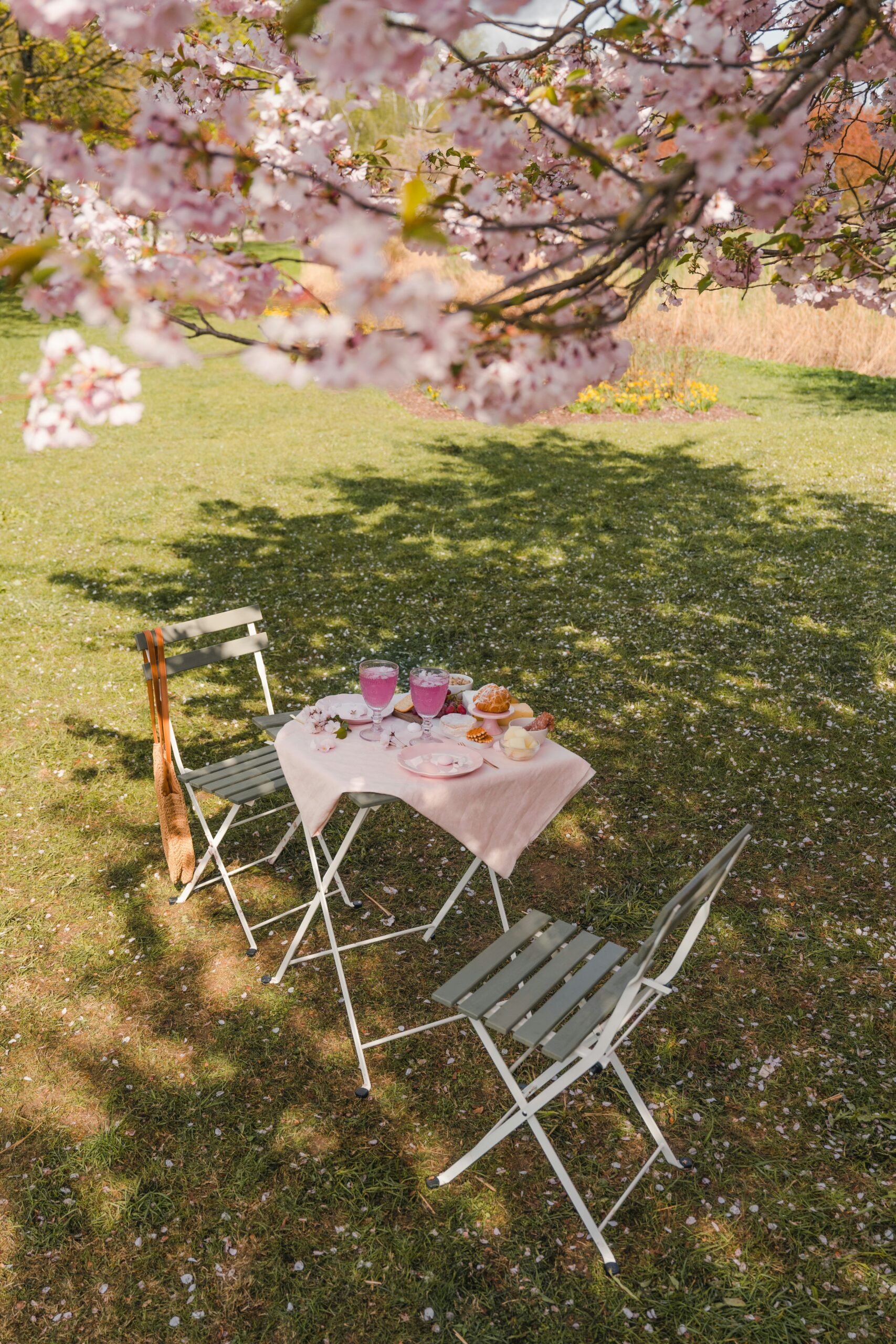
Cherry blossoms create a magical pink canopy in Kyoto’s historic gardens
Take for example the Kyoto Botanical Garden, a vast green space in the city featuring cherry trees, open lawns, a conservatory, and gentle streams—ideal for relaxed outdoor time.
Or the Shugakuin Imperial Villa gardens, with strolling paths, pond features, stone bridges and sweeping views of the hills—designed to incorporate the surrounding scenery (a technique known as shakkei).
These gardens lend themselves not only to sightseeing but to lingering moments of calm—perfect for a picnic and photo session in kimono.
Because the settings are so aesthetically composed — trees, water, stone lanterns, wooden bridges — they offer natural framing for your kimono-wearing photo experience. The visual contrast between the vibrant colors of a kimono and the subtle hues of the garden enhances the elegance of your appearance.
The Kimono Experience — More Than Just Dressing Up
Wearing a kimono is a ritual of elegance, respect, and transformation. In Kyoto, many visitors choose to rent a kimono and stroll through historic districts, but elevating that experience into a picnic plus professional photo session creates something unique.
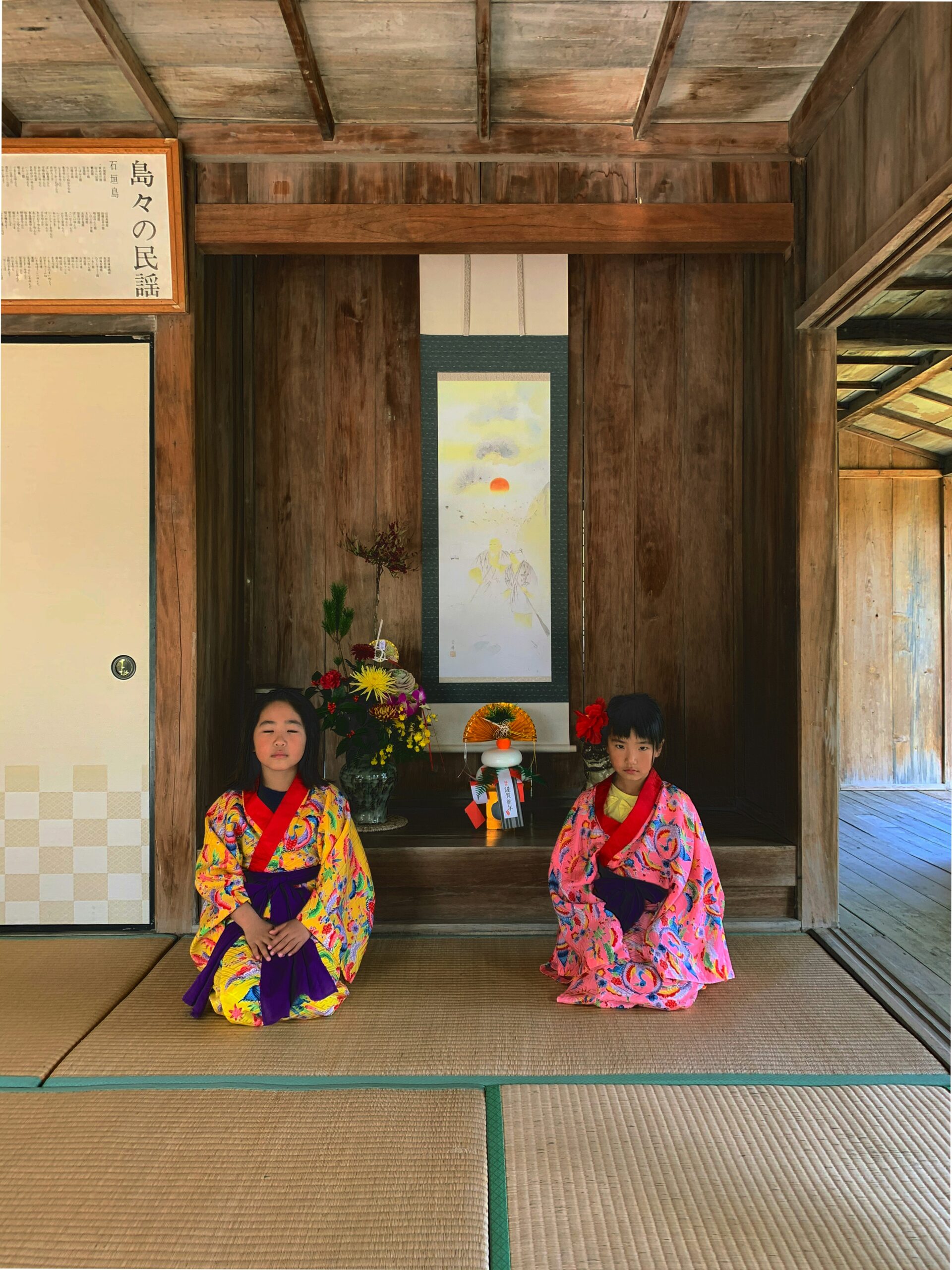
Traditional tea ceremony paired with kimono creates an authentic cultural experience
At AllPhoto-Kyoto, here’s what you’ll enjoy:
- A selection of beautiful kimonos, obi (sash) styles, accessories such as tabi (split-toe socks) and zōri (traditional sandals), and hair styling OPTIONAL depending on your package.
- A relaxed picnic setup in a Japanese garden: a tatami-like mat or low wooden table, seasonal snacks or tea, gentle props to complement the kimono and setting (for example a sensu fan or parasol).
- A professional photographer capturing candid and posed shots: the kimono flowing, the garden backdrop, the picnic setup, the fleeting seasonal moments (cherry blossoms in spring, vibrant maples in autumn, mossy greens in summer).
- Digital and/or print deliverables you can treasure, share, or use for your personal brand, blog, social media, or even as fine art prints.
This experience blends tradition (kimono), nature (garden), and lifestyle (picnic & photography). It’s especially appealing for couples, small groups, friends or solo travelers seeking something beyond the usual sightseeing.
The Picnic Setup & How to Make the Most of It
When planning your kimono-garden picnic photo experience in Kyoto, here are tips to ensure you maximize elegance, comfort, and capture-worthy moments:
1. Choose the Right Garden & Timing
- Early morning or late afternoon light is gentle and flattering — avoid harsh midday sunshine which can wash out colors.
- Consider the season: cherry blossom season (late March–early April) offers pastel blooms; summer gardens bring lush green; autumn brings fiery maples; winter offers bare branches, moss and stillness.
- Ensure the garden permits picnicking — many Kyoto gardens allow casual seating, but you may need to avoid full-blown meals or loud groups.
2. Kimono Styling Tips
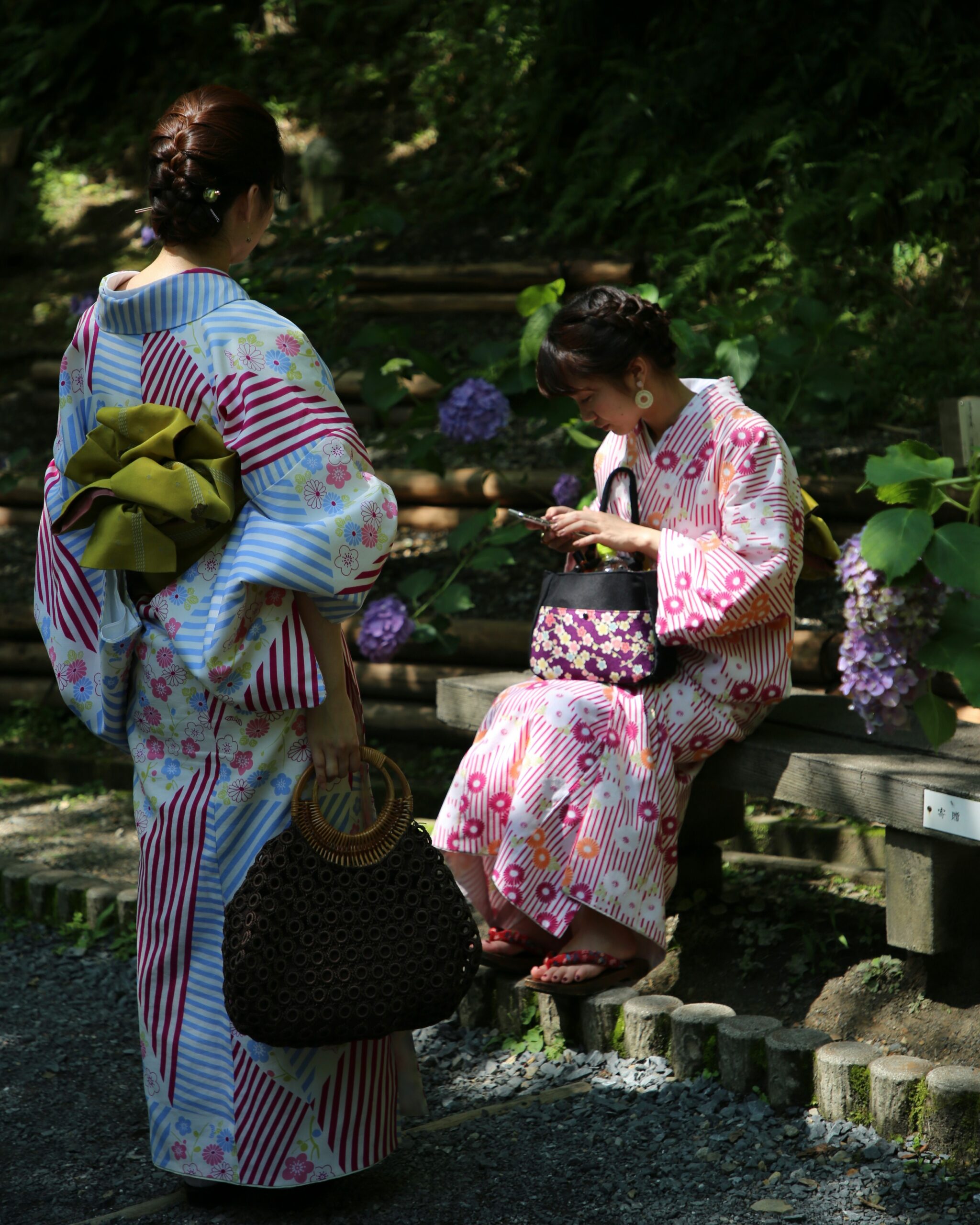
The obi sash serves as the stunning focal point of traditional kimono styling
- Choose a kimono with colors that complement the garden background: soft pastels for blossom scenes, rich reds or earth tones for autumn, cool blues or greens for summer.
- Make sure the obi (sash) stands out — often the focal point — and is well coordinated.
- Footwear: While zōri sandals are traditional, if you’ll move around grass or gravel, ensure your footwear is appropriate and safe.
- Hair and makeup: Simple, elegant styling works best; avoid excessive glitter or heavy Western styling that clashes with the kimono aesthetic.
3. Picnic Essentials
- Keep your setup simple: a low mat or cloth, few tasteful props (a Japanese teapot and cups, sensu fan, seasonal flower arrangement or ikebana-inspired branch).
- Choose light snacks or sweets (for example wagashi, seasonal fruit) and a thermos of matcha or sencha — so you remain mobile and comfortable in kimono.
- Be mindful of garden rules (e.g., no large umbrellas, no loud music, no cleanup hassle) — the elegance comes from subtlety.
4. Photography Considerations
- Ask your photographer to incorporate full-body shots, half-body detail shots (focus on obi or sleeve movements), and environment shots (kimono + garden together).
- Use natural props: a stone lantern, waterfall, pond reflection, stepping stones, wooden bridge. Gardens in Kyoto are full of these features.
- Move slowly and naturally — small gestures like adjusting the obi, holding a cup of tea, looking sideways at the maples, walking along a garden path — create life in the photos.
- Capture candid moments between posed ones — the kimono fabric flowing, the breeze in your sleeves, natural laughter. These often become the most memorable.
Seasonal Inspiration: What to Expect in Each Season
Here’s how each season in Kyoto changes the tone of your kimono-garden picnic experience, and how to make the most of it.
Spring (March – April)
Cherry blossoms (sakura) create soft pink canopies over paths and ponds. The fleeting nature of the blossoms adds romantic urgency.
- Ideal kimono colors: pale pinks, lilacs, soft mint greens.
- Picnic props: sakura petals, light sweets, tea.
- Photo tip: Capture falling petals, reflections in water, and the contrast of your kimono against the blooms.
Summer (May – August)
The greenery in Kyoto gardens becomes lush and vibrant. Streams sparkle, moss is deep, shade is dense.
- Ideal kimono colors: cool blues, whites, light greys, mint green to contrast with the greenery.
- Picnic props: iced matcha, seasonal fruit, perhaps a folding sensu fan for a breeze.
- Photo tip: Use shaded paths and water features to avoid glare. Make use of the vivid green background as a canvas for your kimono.
Autumn (September – November)
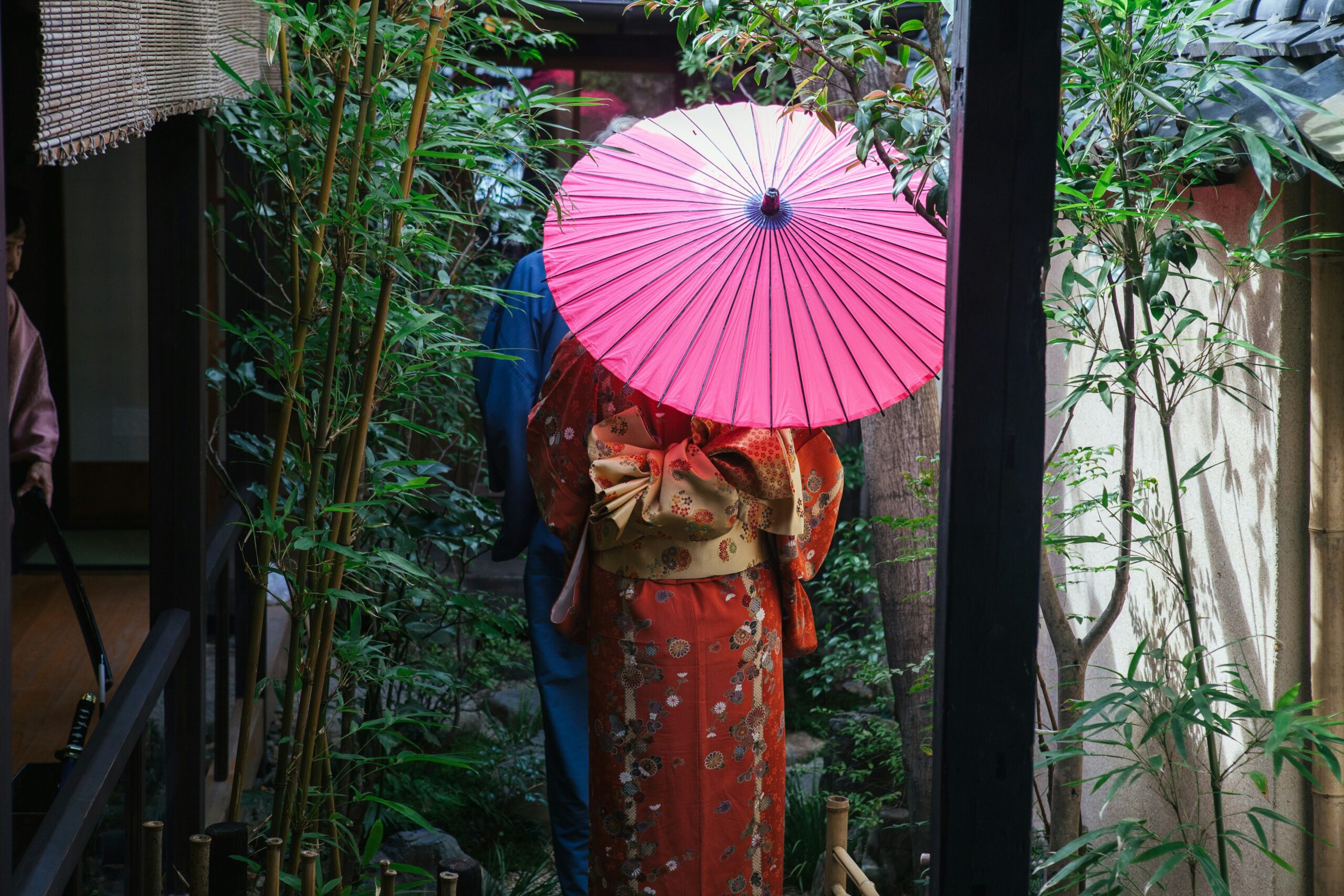
Autumn transforms Kyoto gardens into a masterpiece of fiery reds and golden hues
Kyoto’s famed autumn leaves (kōyō) turn vivid reds, oranges and golds — a perfect match with richer kimono tones.
- Ideal kimono colors: deep reds, burnt orange, gold accents, forest green.
- Picnic props: roasted sweet potatoes (imo), chestnut sweets, warm tea.
- Photo tip: Shoot during golden hour (just before sunset) to capture warm light illuminating the leaves and kimono fabric.
Winter (December – February)
Bare branches, mossy stones, tea house courtyards become more visible. A kimono‐picnic might be more of a tranquil tea under a wooden canopy or near a pond rather than a full spread.
- Ideal kimono colors: deep navy, charcoal, rich plum, subtle metallic threads.
- Picnic props: a warm teapot, wool shawl or elegant haori jacket, a delicate wagashi sweet.
- Photo tip: Focus on texture — fabric, stone, moss, wooden architecture. The stillness of winter gardens amplifies elegance.
Choosing the Right Garden in Kyoto
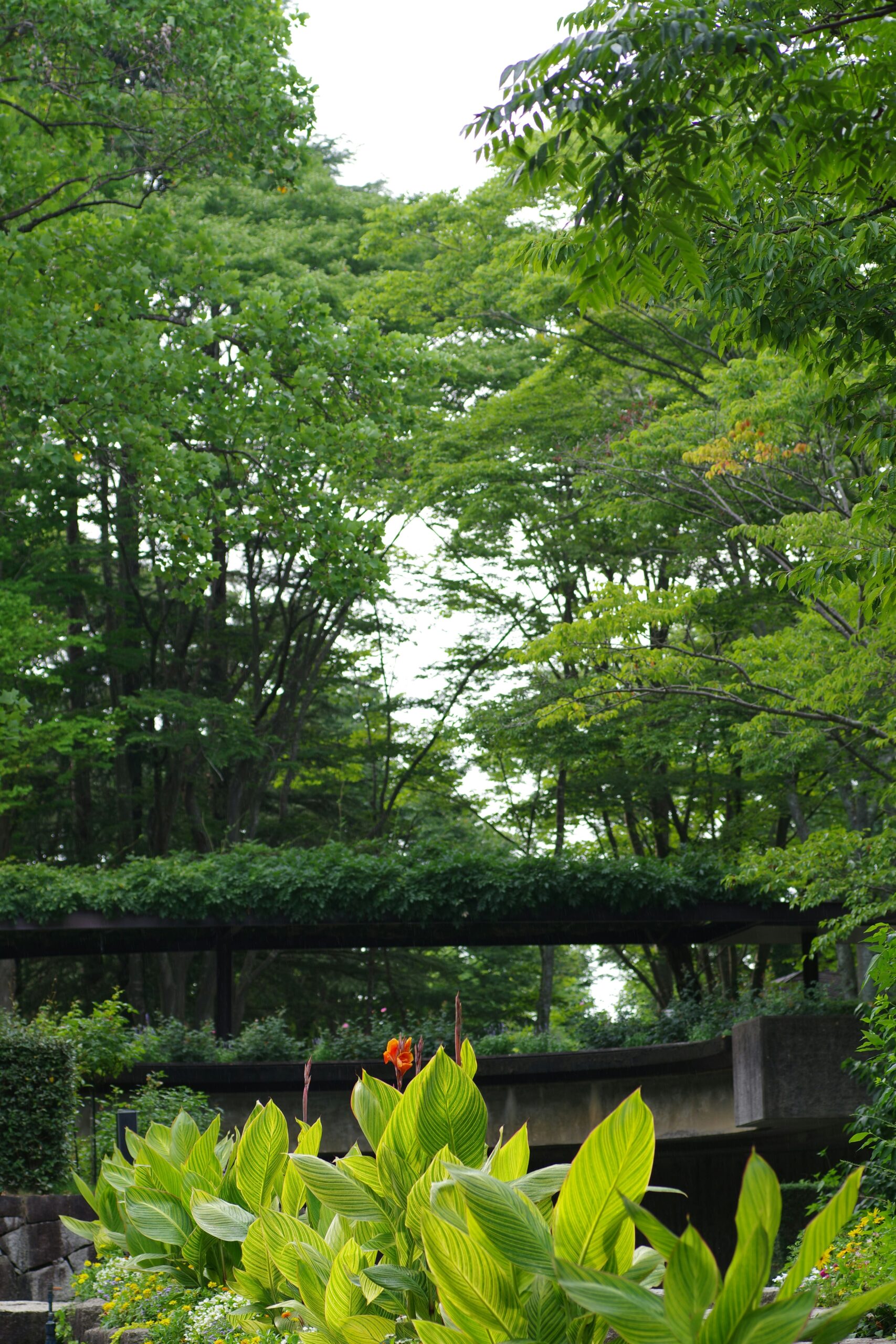
Stone lanterns and koi ponds create perfect photo opportunities in traditional Japanese gardens
Kyoto has numerous gardens, both public and temple‐attached, each offering different atmospheres and suitability for your kimono picnic session. Here are some top picks and what to look for:
- The Kyoto Botanical Garden (Sakyō-ku) offers wide lawns, cherry trees, ponds and open space—ideal for a relaxed picnic stroll.
- The Shugakuin Imperial Villa gardens (Higashiyama hills) offer expansive strolling gardens, water features, bridges and sweeping vistas—great for romantic or elevated photos.
- Other “hidden gem” gardens (less crowded) like the smaller machiya courtyards near Gion offer intimate backdrops if you prefer a cozy scene.
When choosing: check access (some gardens require reservation), check picnic policy (some may restrict food setups), and pick a time of day with favorable light.
How AllPhoto-Kyoto Makes It Easy
At AllPhoto-Kyoto, we provide a seamless experience so you can focus on enjoying your kimono and garden time. Here’s what’s included:
- Kimono rental & styling – Choose your kimono and have it fitted, complete with obi and accessories.
- Picnic set-up – We bring the mat, low table or traditional seating, seasonal props, tea/refreshments.
- Photography session – Our professional photographers know the best garden spots, the best angles, the best time of day for light in Kyoto.
- Post-processing & delivery – You’ll receive high-resolution digital images (and optionally prints), ready to share or frame.
- Flexible options – Solo, couple, group sessions; half-day or full-day; breakfast picnic, afternoon picnic, sunset photo session.
- Location advice – We help you pick the garden that suits your vision (blossoms, autumn leaves, green canopy, winter calm) and help with logistics.
By combining kimono rental, picnic styling and professional photography, we turn a beautiful idea into a fully realised experience — one that becomes both a memory and a set of stunning images.
Tips for Booking & Preparing
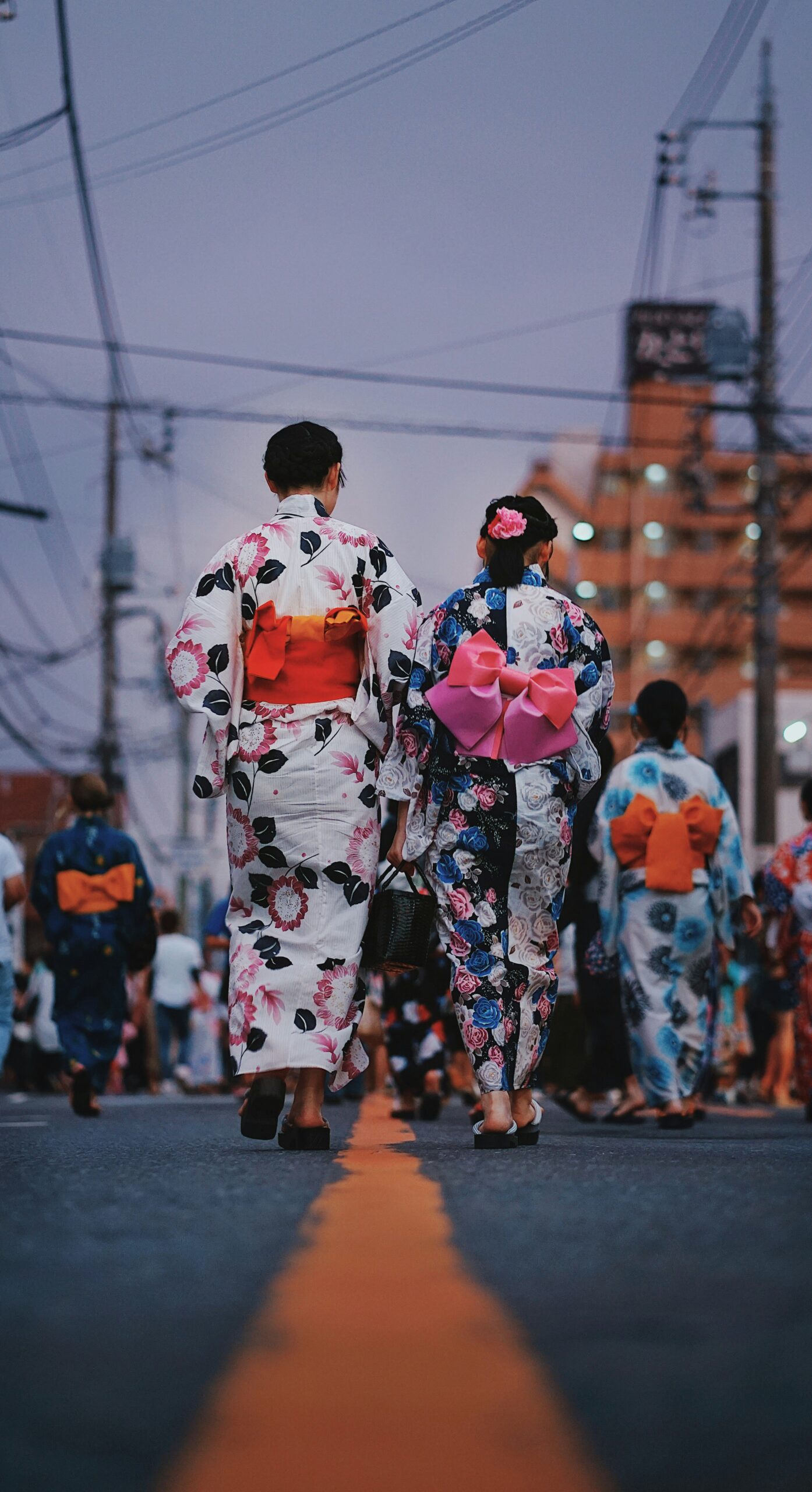
Couples create timeless memories with professional kimono photography in Kyoto’s picturesque gardens
- Book early, especially in peak seasons (cherry blossom in spring; autumn leaves in fall). Gardens fill up and kimono rentals may be limited.
- Communicate your vision: tell us if you prefer a cherry-blossom backdrop, a bamboo grove, an autumn maples setting, or a winter mossy garden.
- Arrive a little early to ensure you’re comfortable in the kimono, and the picnic setup is ready.
- Bring your own small accessories: a parasol, a personal fan, minimal jewellery — but avoid bulky items that clash with traditional aesthetics.
- Be flexible with weather: Kyoto weather can change; if rain is forecast maybe we choose a more sheltered garden or adjust timing.
- Respect the setting: While having fun, remember to follow garden rules (no large picnics full of trash, be mindful of other visitors, keep kimono clean).
- Enjoy the moment: Don’t worry only about the photos — the magic comes from the combination of kimono, garden, nature and calm. The best photos often come when you relax, laugh, stroll, sip tea.
Concluding Thoughts
Picnicking in a Japanese garden while wearing a kimono is not just a photoshoot. It’s a moment of cultural immersion, aesthetic harmony, and personal elegance. In Kyoto, where gardens reflect centuries of aesthetic design and nature is always in conversation with tradition, this experience becomes something truly memorable.
Your kimono, the gentle rustle of leaves, the koi pond ripples, the low afternoon light — all merge into a scene you’ll look back on and cherish. And when you work with AllPhoto-Kyoto, you’re not only living the moment, you’re preserving it in images that will last a lifetime.
If you’re ready to capture your kimono-garden memory in Kyoto, visit AllPhoto-Kyoto and let us help you plan the perfect experience.

コメント